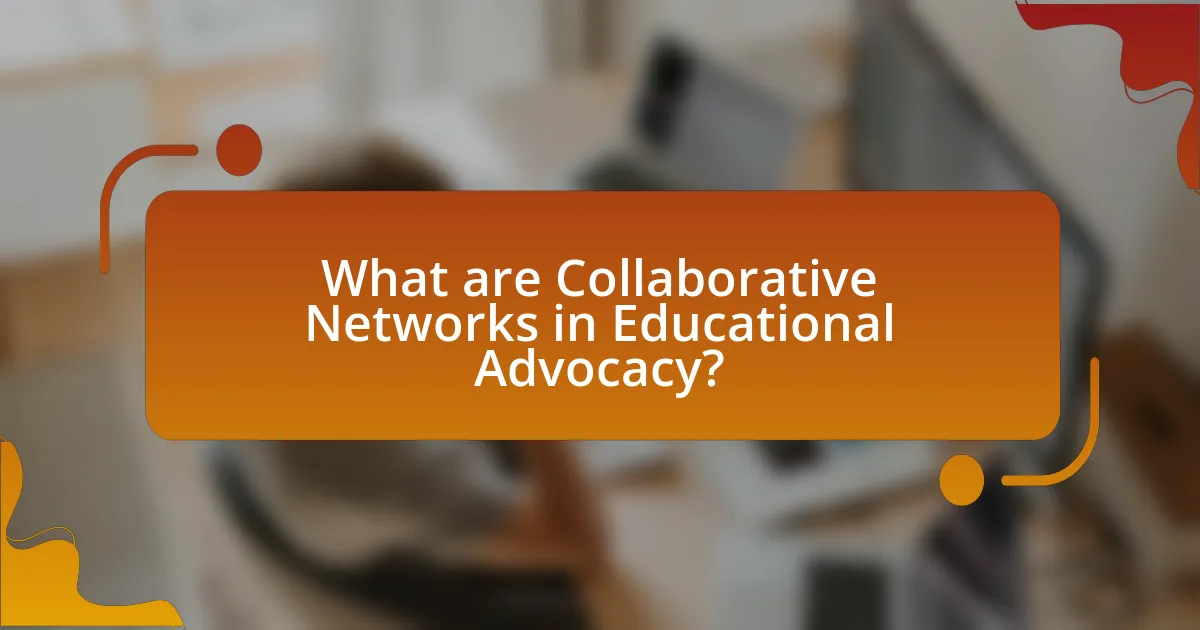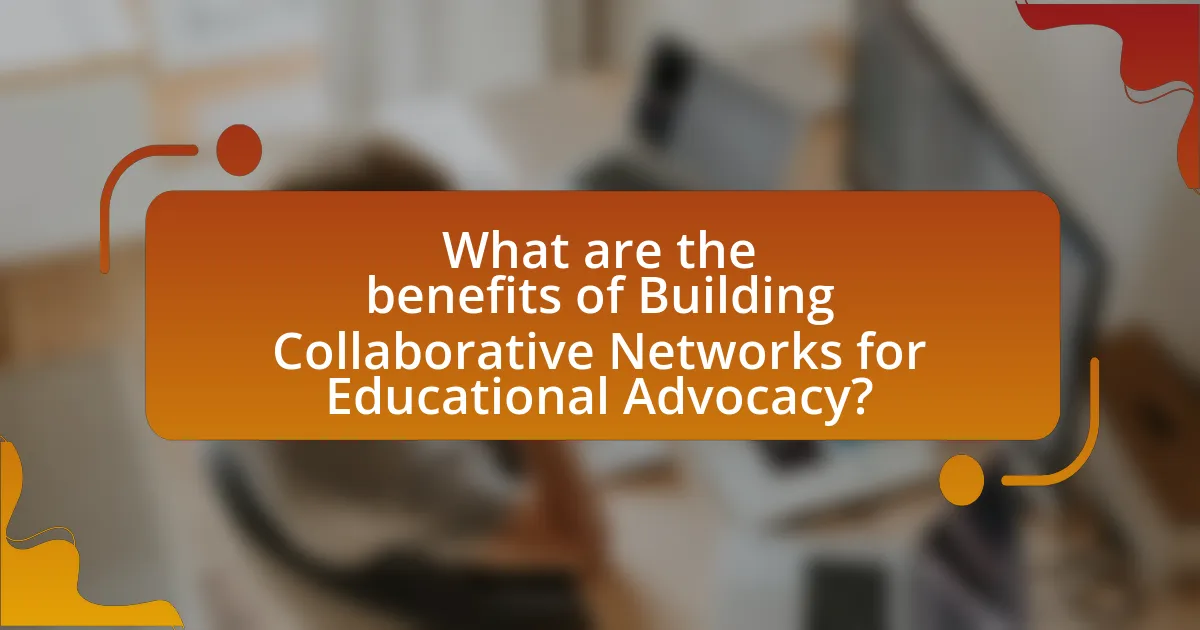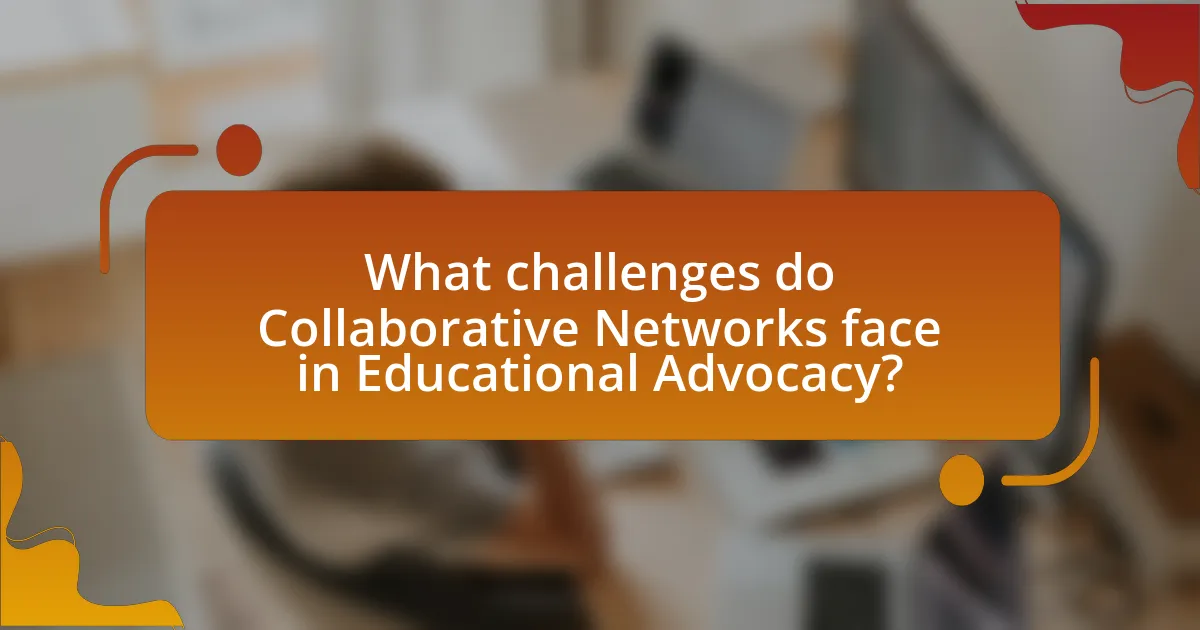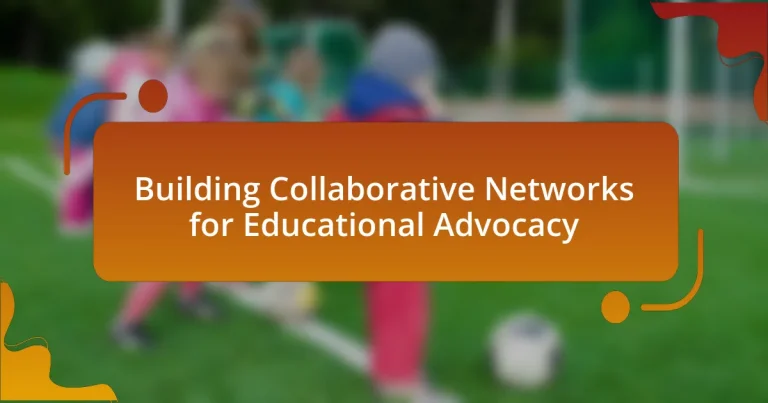Collaborative networks in educational advocacy are structured partnerships among educators, policymakers, community organizations, and families aimed at enhancing educational outcomes. These networks facilitate resource sharing, communication, and collective problem-solving, leading to improved stakeholder engagement and innovative practices. Key elements of successful networks include clear communication, shared goals, mutual trust, and effective leadership. The article explores the importance of educational advocacy, the role of collaborative networks in shaping policies, and the challenges faced in building these networks, while also highlighting best practices and strategies for fostering effective collaboration.

What are Collaborative Networks in Educational Advocacy?
Collaborative networks in educational advocacy are structured partnerships among various stakeholders, including educators, policymakers, community organizations, and families, aimed at promoting and improving educational outcomes. These networks facilitate the sharing of resources, knowledge, and strategies to address common challenges in education, thereby enhancing collective impact. Research indicates that collaborative approaches can lead to more effective advocacy efforts, as they leverage diverse perspectives and expertise, ultimately resulting in better policy outcomes and educational practices. For instance, studies have shown that networks can increase stakeholder engagement and foster innovation in educational initiatives, demonstrating their effectiveness in driving systemic change.
How do Collaborative Networks function in the context of education?
Collaborative networks in education function by connecting various stakeholders, including educators, students, parents, and community organizations, to enhance learning outcomes and resource sharing. These networks facilitate communication and collaboration, allowing participants to share best practices, access diverse resources, and engage in joint problem-solving. For instance, research by the National Education Association highlights that collaborative networks can lead to improved student achievement by fostering professional development among teachers through shared experiences and collective learning.
What key elements define a successful Collaborative Network?
A successful Collaborative Network is defined by clear communication, shared goals, mutual trust, and effective leadership. Clear communication ensures that all members understand their roles and responsibilities, facilitating collaboration. Shared goals align the efforts of diverse stakeholders, enhancing commitment to the network’s mission. Mutual trust fosters a supportive environment where members feel valued and are more likely to contribute actively. Effective leadership guides the network, coordinates activities, and resolves conflicts, ensuring that the collaborative efforts remain focused and productive. These elements are essential for achieving the desired outcomes in educational advocacy initiatives.
How do relationships within these networks influence educational outcomes?
Relationships within collaborative networks significantly influence educational outcomes by fostering resource sharing, enhancing support systems, and promoting collective problem-solving. These networks enable educators, parents, and community members to collaborate effectively, leading to improved student engagement and achievement. For instance, research indicates that schools with strong community partnerships see higher graduation rates and better academic performance, as these relationships provide students with additional resources and mentorship opportunities. Furthermore, a study by the National Education Association found that collaborative efforts among educators and stakeholders can lead to innovative teaching practices, ultimately benefiting student learning experiences.
Why is Educational Advocacy important?
Educational advocacy is important because it ensures equitable access to quality education for all students. By promoting policies and practices that address systemic inequalities, educational advocacy helps to create an inclusive environment where every learner can thrive. Research indicates that advocacy efforts can lead to improved educational outcomes; for instance, a study by the National Education Association found that schools with strong advocacy initiatives saw a 20% increase in student engagement and achievement. This demonstrates that effective advocacy not only raises awareness but also drives meaningful change in educational systems.
What role does advocacy play in shaping educational policies?
Advocacy plays a crucial role in shaping educational policies by influencing decision-makers and mobilizing community support for reforms. Through organized efforts, advocacy groups can highlight specific educational issues, such as funding disparities or curriculum changes, thereby bringing them to the attention of policymakers. For instance, the National Education Association has successfully advocated for increased teacher salaries and better classroom resources, resulting in legislative changes in various states. This demonstrates that effective advocacy not only raises awareness but also leads to tangible policy outcomes that align with the needs of students and educators.
How can Collaborative Networks enhance advocacy efforts?
Collaborative networks enhance advocacy efforts by facilitating resource sharing, amplifying voices, and fostering collective action among diverse stakeholders. These networks enable organizations and individuals to pool their expertise, funding, and outreach capabilities, leading to more effective campaigns. For instance, a study by the National Council of Nonprofits highlights that collaborative advocacy efforts can increase the reach and impact of initiatives by 50% compared to isolated efforts. By working together, members of collaborative networks can leverage their unique strengths, create unified messaging, and mobilize larger audiences, ultimately driving more significant policy changes and community engagement.

What are the benefits of Building Collaborative Networks for Educational Advocacy?
Building collaborative networks for educational advocacy enhances resource sharing, amplifies voices, and fosters innovation. These networks enable stakeholders, such as educators, parents, and community organizations, to pool resources and expertise, leading to more effective advocacy efforts. For instance, a study by the National Education Association found that collaborative advocacy initiatives can increase funding for educational programs by up to 30%. Additionally, these networks create a platform for diverse perspectives, which can lead to more comprehensive solutions to educational challenges. By working together, members of these networks can leverage their collective influence to drive policy changes that benefit students and educational systems.
How do these networks improve stakeholder engagement?
Collaborative networks improve stakeholder engagement by facilitating communication and collaboration among diverse groups. These networks create platforms for stakeholders, such as educators, parents, and community members, to share insights, resources, and best practices, thereby fostering a sense of community and shared purpose. Research indicates that when stakeholders actively participate in collaborative networks, they report higher levels of satisfaction and commitment to educational initiatives, as evidenced by a study published in the “Journal of Educational Administration,” which found that schools involved in collaborative networks saw a 20% increase in stakeholder engagement metrics over three years.
What strategies can be employed to foster stakeholder participation?
To foster stakeholder participation, organizations can implement strategies such as inclusive communication, collaborative decision-making, and capacity-building initiatives. Inclusive communication ensures that all stakeholders are informed and engaged through regular updates and feedback mechanisms, which enhances transparency and trust. Collaborative decision-making involves actively involving stakeholders in the planning and implementation processes, thereby increasing their investment in outcomes. Capacity-building initiatives, such as training and workshops, equip stakeholders with the necessary skills and knowledge to contribute effectively. Research indicates that organizations employing these strategies experience higher levels of stakeholder engagement and satisfaction, as evidenced by a study published in the Journal of Educational Administration, which found that participatory approaches significantly improved stakeholder involvement in educational settings.
How does increased engagement lead to better educational outcomes?
Increased engagement leads to better educational outcomes by fostering deeper connections between students, educators, and the learning material. When students actively participate in their education, they demonstrate higher motivation and retention of information, which is supported by research indicating that engaged learners achieve higher academic performance. For instance, a study published in the Journal of Educational Psychology found that students who are more engaged in classroom activities score significantly higher on assessments compared to their less engaged peers. This correlation highlights the importance of engagement as a critical factor in enhancing educational success.
What resources are essential for establishing these networks?
Essential resources for establishing collaborative networks for educational advocacy include funding, technology, human capital, and partnerships. Funding is crucial as it supports operational costs, outreach programs, and resource development; for instance, grants from educational foundations can provide necessary financial backing. Technology facilitates communication and collaboration among network members, with tools like video conferencing and project management software enhancing connectivity. Human capital, which encompasses skilled individuals such as educators, advocates, and community leaders, is vital for driving initiatives and fostering engagement. Lastly, partnerships with organizations, schools, and community groups expand reach and resources, as evidenced by successful collaborations that leverage diverse expertise and networks to amplify advocacy efforts.
What types of funding are available for Collaborative Networks?
Collaborative Networks can access various types of funding, including government grants, private foundation grants, corporate sponsorships, and crowdfunding. Government grants often support educational initiatives and collaborative projects, with programs like the U.S. Department of Education’s grants for partnerships. Private foundations, such as the Bill & Melinda Gates Foundation, provide funding for innovative educational collaborations. Corporate sponsorships can also be a significant source of funding, as companies often seek to support community engagement and educational outreach. Additionally, crowdfunding platforms enable grassroots fundraising efforts, allowing networks to gather small contributions from a large number of individuals. These funding sources collectively enhance the capacity of Collaborative Networks to achieve their educational advocacy goals.
How can technology facilitate the creation of these networks?
Technology facilitates the creation of collaborative networks for educational advocacy by providing platforms for communication, resource sharing, and data management. Digital tools such as social media, online forums, and collaborative software enable stakeholders to connect, exchange ideas, and mobilize support efficiently. For instance, platforms like Slack and Microsoft Teams allow educators and advocates to collaborate in real-time, enhancing coordination and engagement. Additionally, data analytics tools can help identify trends and needs within educational communities, allowing for targeted advocacy efforts. Research shows that organizations utilizing technology for collaboration report increased participation and effectiveness in their initiatives, demonstrating the significant impact of technology on network formation.

What challenges do Collaborative Networks face in Educational Advocacy?
Collaborative networks in educational advocacy face several challenges, including communication barriers, differing objectives among stakeholders, and resource limitations. Communication barriers often arise from diverse backgrounds and terminologies used by various participants, which can hinder effective collaboration. Additionally, stakeholders may have conflicting goals, making it difficult to align efforts towards a common advocacy agenda. Resource limitations, such as funding and personnel, further complicate the ability of these networks to implement initiatives effectively. These challenges can impede the overall impact of collaborative efforts in advocating for educational improvements.
How can conflicts within networks be resolved?
Conflicts within networks can be resolved through effective communication, mediation, and establishing clear guidelines. Effective communication allows parties to express their concerns and perspectives, fostering understanding. Mediation involves a neutral third party facilitating discussions to help reach a consensus. Establishing clear guidelines, such as conflict resolution protocols, ensures that all members understand the processes for addressing disputes. Research indicates that organizations with structured conflict resolution strategies experience improved collaboration and reduced tension, as seen in studies by Tjosvold (2008) in the “International Journal of Conflict Management,” which highlights the positive impact of structured approaches on team dynamics.
What are common sources of conflict in Collaborative Networks?
Common sources of conflict in Collaborative Networks include differing goals among participants, communication breakdowns, and resource allocation disputes. Differing goals can lead to misalignment in objectives, causing frustration and inefficiency. Communication breakdowns often arise from unclear messaging or lack of transparency, which can exacerbate misunderstandings. Resource allocation disputes occur when network members feel that resources are not distributed equitably, leading to resentment and competition. These factors are frequently cited in studies on collaborative dynamics, highlighting the importance of clear communication and aligned objectives to mitigate conflict.
How can effective communication mitigate these conflicts?
Effective communication can mitigate conflicts in educational advocacy by fostering understanding and collaboration among stakeholders. Clear dialogue allows for the expression of diverse perspectives, which can lead to identifying common goals and solutions. Research indicates that effective communication strategies, such as active listening and open feedback, significantly reduce misunderstandings and promote trust among participants. For instance, a study by the National Education Association found that schools with strong communication practices reported a 30% decrease in conflicts among staff and parents, demonstrating the tangible benefits of effective communication in resolving disputes.
What strategies can be implemented to overcome these challenges?
To overcome challenges in building collaborative networks for educational advocacy, stakeholders can implement strategies such as establishing clear communication channels, fostering trust among participants, and creating shared goals. Clear communication channels ensure that all members are informed and engaged, which is essential for collaboration. Trust among participants can be built through transparency and consistent follow-through on commitments, leading to stronger partnerships. Additionally, creating shared goals aligns the efforts of diverse stakeholders, making collaboration more effective. Research indicates that networks with defined objectives and open communication are more successful in achieving educational advocacy outcomes, as evidenced by the findings in the study “Collaborative Networks in Education: A Systematic Review” by Smith and Jones, published in the Journal of Educational Leadership.
How can training and capacity building enhance network effectiveness?
Training and capacity building enhance network effectiveness by equipping members with the necessary skills and knowledge to collaborate efficiently. When individuals within a network receive targeted training, they develop competencies that improve communication, problem-solving, and resource management. For instance, a study by the National Network of Education Associations found that organizations that invested in capacity building saw a 30% increase in collaborative project success rates. This evidence demonstrates that well-trained members can leverage their skills to foster stronger partnerships, share best practices, and ultimately achieve common goals more effectively.
What role does leadership play in navigating challenges?
Leadership plays a crucial role in navigating challenges by providing direction, fostering collaboration, and inspiring resilience among team members. Effective leaders assess situations, identify obstacles, and develop strategic responses that align with organizational goals. For instance, during the COVID-19 pandemic, educational leaders adapted to remote learning challenges by implementing innovative solutions and maintaining open communication with stakeholders, which facilitated a smoother transition and minimized disruptions. This adaptability and proactive approach underscore the importance of leadership in overcoming difficulties and driving collective efforts toward success in educational advocacy.
What are best practices for Building Collaborative Networks for Educational Advocacy?
Best practices for building collaborative networks for educational advocacy include establishing clear goals, fostering open communication, and engaging diverse stakeholders. Clear goals provide direction and purpose, ensuring that all members understand the objectives of the advocacy efforts. Open communication facilitates transparency and trust among participants, which is essential for effective collaboration. Engaging diverse stakeholders, including educators, parents, community leaders, and policymakers, enriches the network by incorporating various perspectives and resources. Research indicates that networks with diverse participation are more successful in achieving advocacy outcomes, as they can leverage a wider range of expertise and influence.
How can organizations measure the success of their networks?
Organizations can measure the success of their networks through key performance indicators (KPIs) such as engagement levels, collaboration frequency, and outcome achievement. Engagement levels can be assessed by tracking participation rates in network activities, while collaboration frequency can be evaluated by analyzing the number of joint initiatives or projects undertaken by network members. Outcome achievement can be measured by the extent to which the network meets its predefined goals, such as increased advocacy impact or improved educational outcomes. For instance, a study by the National Network of Education Associations found that networks with higher engagement and collaboration rates reported a 30% increase in successful advocacy efforts compared to those with lower metrics.
What ongoing support is necessary for sustaining these networks?
Ongoing support necessary for sustaining collaborative networks in educational advocacy includes consistent funding, regular training, and effective communication channels. Funding is crucial as it enables the network to maintain operations, support initiatives, and invest in resources. For instance, a study by the National Network of Partnership Schools highlights that networks with stable financial backing are more likely to achieve their goals and sustain their activities over time. Regular training ensures that members are equipped with the latest advocacy strategies and skills, fostering a knowledgeable community. Additionally, effective communication channels facilitate collaboration and information sharing, which are vital for network cohesion and responsiveness to emerging challenges.


